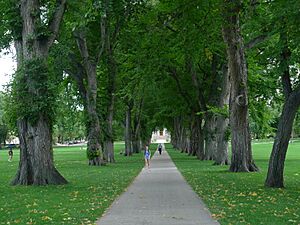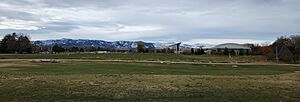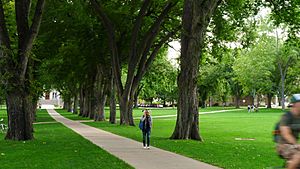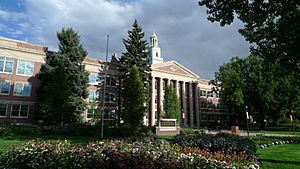Colorado State University facts for kids
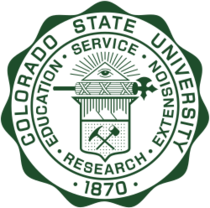 |
|
|
Former names
|
Colorado Agricultural College (1870–1935) Colorado State College of Agriculture and Mechanic Arts (1935–1950) Colorado Agricultural and Mechanical College (1950–1957) |
|---|---|
| Motto | "Education, Service, Research, Extension" |
| Type | Public land-grant research university |
| Established | 1870 |
|
Parent institution
|
Colorado State University System |
| Accreditation | HLC |
|
Academic affiliations
|
|
| Endowment | $580.5 million (2023) |
| Chancellor | Anthony A. Frank |
| President | Amy Parsons |
|
Academic staff
|
1,468 |
|
Administrative staff
|
4,379 |
| Students | 34,110 (fall 2024) |
| Undergraduates | 26,500 (fall 2024) |
| Postgraduates | 7,610 (fall 2024) |
| Location |
,
,
United States
40°34′34″N 105°04′51″W / 40.5762°N 105.0808°W |
| Campus | Midsize city, 4,773 acres (19.32 km2) |
| Other campuses | |
| Newspaper | Rocky Mountain Collegian |
| Colors | Green and Gold |
| Nickname | Rams |
|
Sporting affiliations
|
NCAA Division I FBS – Mountain West |
| Mascot | CAM the Ram |
 |
|
Colorado State University (also known as Colorado State or CSU) is a public research university in Fort Collins, Colorado. It is the main university in the Colorado State University System. The school started in 1870 as the Colorado Agricultural College and got its current name in 1957.
In 2024, about 34,000 students attended CSU. The university has around 1,500 teachers in eight colleges and 55 different departments. Students can earn bachelor's degrees in 65 subjects and master's degrees in 55 subjects. CSU also offers doctoral degrees in 40 areas, plus a special degree in veterinary medicine (animal medicine).
CSU is known for its important research. In 2023, the university spent over $498 million on research and development. Because of this, it is considered a top-level research university.
The campus has many interesting places. These include the Engines and Energy Conversion Laboratory, the University Center for the Arts, and the James L. Voss Veterinary Teaching Hospital.
The university's sports teams are called the Colorado State Rams. They compete in the NCAA Division I Mountain West Conference. Famous athletes from CSU include swimmer Amy Van Dyken, who won six Olympic gold medals. Other former students have won Nobel Prizes, become astronauts, and served as governors of Colorado.
Contents
History of the University
How It All Started
CSU was first called the Colorado Agricultural College. It was created because of the Morrill Act of 1862, a law that gave land to states to build colleges. The governor of the Colorado Territory, Edward M. McCook, signed the act to create the college in 1870. At first, there was very little money to build the school.
The first piece of land for the campus was given in 1871. The first building was a small, red brick building nicknamed the "Claim Shanty." It was finished in 1874 after local people and businesses helped raise money.
After Colorado became a state in 1876, the government created a board to run the school. The first main building, called Old Main, was finished in 1878. The first five students started classes on September 1, 1879. By 1880, there were 25 students.
The first classes were simple, like arithmetic, English, and U.S. history. The first president, Elijah Evan Edwards, resigned in 1882. The next president, Charles Ingersoll, came from Michigan State Agricultural College. Under his leadership, the college grew.
A Time of Growth
Under President Ingersoll, the college started doing more agricultural research. A new law in 1887 provided money for experiment stations, where scientists could study farming. The school also added new subjects like engineering, animal science, and liberal arts. The college even started offering special classes for women, such as drawing and foreign languages.
One important early professor was Louis George Carpenter. He started the first college program for irrigation engineering, which is the study of how to supply water to land for farming. He was a key person in helping the college grow into a major university.
By the early 1900s, the college was expanding quickly. President Barton Aylesworth supported sports and clubs. Football returned to the college, and the women's basketball team won its first championship in 1903.
Becoming a Modern University
Charles Lory became president in 1909 and led the school for 31 years. He helped the school grow and become financially stable. During World War I, the college helped with the war effort by teaching farmers how to produce more food.
During the Great Depression of the 1930s, the college helped people in Colorado who were struggling. In 1935, the school's name was changed to the Colorado State College of Agriculture and Mechanic Arts, or Colorado A&M.
During World War II, the campus looked like a military base, with many soldiers training there. After the war, many soldiers returned to study at the college.
In the 1950s, President Bill Morgan helped the college become a true university. New dorms were built, and the school began offering advanced degrees like doctorates. In 1957, the school officially became Colorado State University.
The 1960s and 1970s were a time of student activism. Students protested for civil rights and against the Vietnam War. In 1970, the historic Old Main building was destroyed in a fire.
In 2019, Joyce E. McConnell became the first female president of CSU. The current president, Amy Parsons, started in 2023.
Life on Campus
CSU is in Fort Collins, a city at the base of the Rocky Mountains. The main campus is 583 acres and includes a large veterinary hospital. The university also has other campuses for research, including a mountain campus called Pingree Park.
The Main Campus
The heart of the campus is the Oval, a large grassy area surrounded by 65 American Elm trees. It was designed in 1909 and is still a popular landmark. Many important buildings, like the Administration Building, are located around the Oval.
Another central spot is the main plaza, where you can find the Lory Student Center and Morgan Library. The Lory Student Center is a place for students to eat, study, and meet. Morgan Library has over 2 million books and a 24-hour study area.
The oldest building still standing on campus is Spruce Hall, built in 1881. The university also has a modern University Center for the Arts, which is located in the historic old Fort Collins High School building. It includes theaters, music halls, and art museums.
Veterinary Hospital
The James L. Voss Veterinary Teaching Hospital is one of the best in the country. It has 28 different specialty areas, from emergency care to cancer treatment for animals. It treats nearly 47,000 animal patients each year and helps train future veterinarians.
Foothills Campus
The Foothills Campus is used for research. It is home to the atmospheric sciences department and centers that study diseases, engineering, and animal reproduction.
What You Can Study
Colorado State offers 150 different programs in 8 colleges. Students can study subjects like biomedical sciences, engineering, agriculture, and business. CSU also offers many degrees online.
The university has about 1,540 teachers, and the student-to-teacher ratio is 17 to 1. This means classes are often small enough for students to get personal attention.
Famous Research at CSU
CSU is known for its important research projects.
- A study at CSU in 1961 was important for the creation of the Peace Corps.
- Researchers at the Engines and Energy Conversion Laboratory have developed technology to make small engines cleaner.
- The Center for Disaster and Risk Analysis studies how to reduce the harm caused by disasters like hurricanes and oil spills.
- CSU has a major research program in infectious diseases, working on vaccines for some of the world's most serious illnesses.
- The university's Animal Cancer Center is the largest of its kind in the world.
Sports at CSU
CSU's sports teams are called the Rams. They compete in the Mountain West Conference at the NCAA Division I level. The university has 17 sports teams, including football, basketball, volleyball, and soccer.
The football team plays its home games at Canvas Stadium, which is located on campus.
The Mascot: CAM the Ram
CSU has had several mascots over the years, including a bear cub and a bulldog. The first ram mascot, named Buck, was introduced in 1946. Today, the beloved mascot is a live ram named CAM the Ram. The name "CAM" comes from the school's old name, Colorado A&M.
Student Activities
Fort Collins is about 65 miles north of Denver. It is close to the Rocky Mountain National Park, so students have many opportunities for hiking, biking, and skiing.
There are over 450 student clubs and organizations at CSU. Many students play intramural sports (sports played between teams from the same university). There are also 30 sport clubs for teams that compete against other universities.
Student Media
CSU has its own student-run newspaper, the Rocky Mountain Collegian, which was started in 1891. There is also a student radio station, KCSU FM, and a student television station, CTV. These give students a chance to learn about journalism and media.
In 2007, the Collegian published a controversial article that said, "Taser This...Bush." This led to a national discussion about free speech at universities.
Greek Life
About 10% of students at CSU join a fraternity or sorority. These groups are involved in many community service projects, such as building homes with Habitat for Humanity.
Images for kids
See also
 In Spanish: Universidad Estatal de Colorado para niños
In Spanish: Universidad Estatal de Colorado para niños



